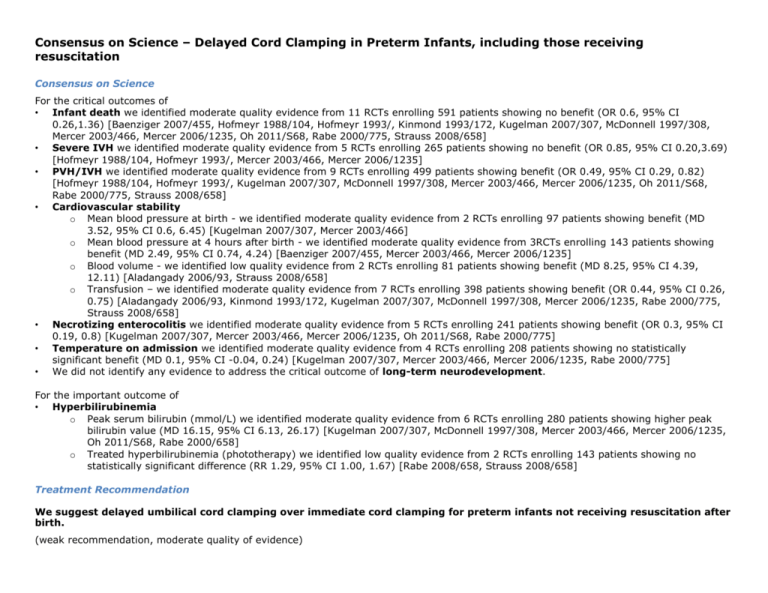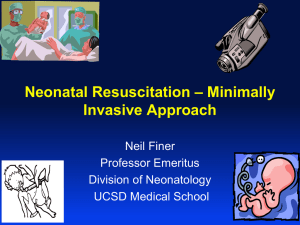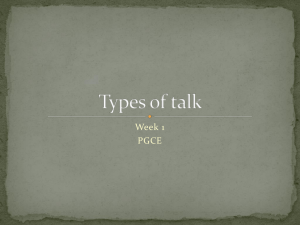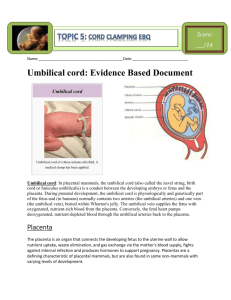Consensus on Science and GRADE Grid
advertisement

Consensus on Science – Delayed Cord Clamping in Preterm Infants, including those receiving resuscitation Consensus on Science For the critical outcomes of • Infant death we identified moderate quality evidence from 11 RCTs enrolling 591 patients showing no benefit (OR 0.6, 95% CI 0.26,1.36) [Baenziger 2007/455, Hofmeyr 1988/104, Hofmeyr 1993/, Kinmond 1993/172, Kugelman 2007/307, McDonnell 1997/308, Mercer 2003/466, Mercer 2006/1235, Oh 2011/S68, Rabe 2000/775, Strauss 2008/658] • Severe IVH we identified moderate quality evidence from 5 RCTs enrolling 265 patients showing no benefit (OR 0.85, 95% CI 0.20,3.69) [Hofmeyr 1988/104, Hofmeyr 1993/, Mercer 2003/466, Mercer 2006/1235] • PVH/IVH we identified moderate quality evidence from 9 RCTs enrolling 499 patients showing benefit (OR 0.49, 95% CI 0.29, 0.82) [Hofmeyr 1988/104, Hofmeyr 1993/, Kugelman 2007/307, McDonnell 1997/308, Mercer 2003/466, Mercer 2006/1235, Oh 2011/S68, Rabe 2000/775, Strauss 2008/658] • Cardiovascular stability o Mean blood pressure at birth - we identified moderate quality evidence from 2 RCTs enrolling 97 patients showing benefit (MD 3.52, 95% CI 0.6, 6.45) [Kugelman 2007/307, Mercer 2003/466] o Mean blood pressure at 4 hours after birth - we identified moderate quality evidence from 3RCTs enrolling 143 patients showing benefit (MD 2.49, 95% CI 0.74, 4.24) [Baenziger 2007/455, Mercer 2003/466, Mercer 2006/1235] o Blood volume - we identified low quality evidence from 2 RCTs enrolling 81 patients showing benefit (MD 8.25, 95% CI 4.39, 12.11) [Aladangady 2006/93, Strauss 2008/658] o Transfusion – we identified moderate quality evidence from 7 RCTs enrolling 398 patients showing benefit (OR 0.44, 95% CI 0.26, 0.75) [Aladangady 2006/93, Kinmond 1993/172, Kugelman 2007/307, McDonnell 1997/308, Mercer 2006/1235, Rabe 2000/775, Strauss 2008/658] • Necrotizing enterocolitis we identified moderate quality evidence from 5 RCTs enrolling 241 patients showing benefit (OR 0.3, 95% CI 0.19, 0.8) [Kugelman 2007/307, Mercer 2003/466, Mercer 2006/1235, Oh 2011/S68, Rabe 2000/775] • Temperature on admission we identified moderate quality evidence from 4 RCTs enrolling 208 patients showing no statistically significant benefit (MD 0.1, 95% CI -0.04, 0.24) [Kugelman 2007/307, Mercer 2003/466, Mercer 2006/1235, Rabe 2000/775] • We did not identify any evidence to address the critical outcome of long-term neurodevelopment. For the important outcome of • Hyperbilirubinemia o Peak serum bilirubin (mmol/L) we identified moderate quality evidence from 6 RCTs enrolling 280 patients showing higher peak bilirubin value (MD 16.15, 95% CI 6.13, 26.17) [Kugelman 2007/307, McDonnell 1997/308, Mercer 2003/466, Mercer 2006/1235, Oh 2011/S68, Rabe 2000/658] o Treated hyperbilirubinemia (phototherapy) we identified low quality evidence from 2 RCTs enrolling 143 patients showing no statistically significant difference (RR 1.29, 95% CI 1.00, 1.67) [Rabe 2008/658, Strauss 2008/658] Treatment Recommendation We suggest delayed umbilical cord clamping over immediate cord clamping for preterm infants not receiving resuscitation after birth. (weak recommendation, moderate quality of evidence) Grade 2B There is insufficient evidence to recommend the approach to cord clamping for preterm infants who do receive resuscitation immediately after birth. Values and Preferences Overall quality of evidence for the question was moderate. Despite drawing evidence from well-conducted randomized controlled trials, the small sample size in most trials and the imprecision associated limited the quality of evidence for many outcomes. Although two larger observational trials were considered, the effects were not sufficiently large or strong to influence the conclusions. The quality of evidence for necrotizing enterocolitis and hyperbilirubinemia was limited by inconsistent definitions of the outcomes measured and inconsistent thresholds for treatment with phototherapy across studies. Balance of consequences favors delayed cord clamping, as desirable consequences probably outweigh undesirable consequences in most settings. The results of randomized controlled trials and non-randomized observational studies with comparison groups were generally consistent. However, small and sick infants who received immediate resuscitation were generally excluded from randomized controlled trials, so data are very limited on this group at highest risk for physiologic instability, complications of prematurity, and mortality who may also realize highest benefit or harm from the intervention. Preference (Babies’ or Parents’) favors delayed clamping, which has received strong popular support through social media and internet sites. The advantages of delayed cord clamping assume heightened importance in resource-limited settings where specialty care for preterm neonates may be limited. Improving initial cardiovascular stability with maintenance of temperature and lower risk of morbidities such as necrotizing enterocolitis and severe intracranial haemorrhage may offer significant survival advantages where neonatal intensive care is not available. In areas where maternal anemia is prevalent and severe, iron supplementation limited, and a safe blood supply often unavailable, the reduction in need for transfusion and improved blood volume at birth have increased significance and help eliminate disparities in health care. Acceptability to staff at delivery is high when delayed cord clamping is introduced in the context of a quality improvement process. Delayed cord clamping requires increased coordination between obstetrical and neonatal providers. The intervention is dependent upon realtime assessment of conditions at delivery (intrapartum haemorrhage, need for neonatal resuscitation). The approach to infants whose condition calls for immediate resuscitation (bradycardia or prolonged apnea) requires very different preparation from routine if ventilation is to be provided with the umbilical cord intact. For this pragmatic reason, as well as uncertainty about the physiologic consequences, insufficient information is currently available to make a general recommendation on umbilical cord clamping for all preterm infants. Cost of delayed cord clamping is negligible and mainly related to the investment in changing behavior. Some reconfiguration of resuscitation equipment is necessary if the initial steps of resuscitation or positive-pressure ventilation are provided with the umbilical cord intact. The long-term savings through reduction of morbidities may more than outweigh the initial investment. Knowledge Gaps • • • Results of ongoing large randomized controlled trials (UK, Australia) Other specific systematic reviews: o Comparison of delayed vs. immediate cord clamping among preterm infant who receive resuscitation with positive-pressure ventilation at birth o Comparison of delayed cord clamping and cord milking Outcome data of high importance o Need for resuscitative intervention at delivery o Long-term neurodevelopment o Hyperbilirubinemia among high-risk populations Reviewer Final Comments For preterm neonates, there is evidence of a benefit to delaying cord clamping for a minimum time ranging from 30 seconds to 3 minutes following delivery. Although there was no clear difference between groups in the risk of death, severe IVH, temperature on admission, those who experienced delayed clamping had higher blood pressures during stabilization, a lower incidence of necrotizing enterocolitis and intracranial hemorrhage of all grades, as well as fewer blood transfusions. Their serum bilirubin peak was higher and there was a trend toward greater use of phototherapy. There are limited data on the hazards or benefits of delayed cord clamping in the preterm infants who required resuscitation and no trial reported the neurodevelopmental outcome at two or three years. The benefits of delayed cord clamping outweigh the risks for both term and preterm infants who do not require resuscitation at birth. Additional research should focus on understanding the physiology and outcomes of delayed cord clamping in the groups of infants who do require immediate resuscitative intervention – asphyxiated term infants and preterm infants who fail to establish spontaneous respirations or who have experienced asphyxial events prior to birth. Additional research should also build upon experimental animal physiology to explore the optimal time for delay and better define the obstetrical and fetal contraindications to delayed cord clamping. GRADE Grid Problem Criteria Is there a problem priority? Benefits & harms of the options What is the overall certainty of this evidence? Judgements ○ No ○ Probably no ○ Uncertain ○ Probably yes x○ Yes ○ Varies ○ No included studies ○ Very low X○ Low x○ Moderate ○ High ○ Important uncertainty or variability ○ Possibly important Is there important uncertainty about how much people value the main outcomes? Research evidence uncertainty or variability ○ Probably no important uncertainty of variability x○ No important uncertainty of variability ○ No known undesirable The overall certainty of evidence is limited by the relatively small number of subjects, the heterogeneity of patient populations, and the relatively long timespan during which studies have been conducted (during which time many practices in neonatology have changed). Evidence on cardiovascular stability comes from relatively few studies, but these studies show consistent results. Evidence on intracranial haemorrhage is more heterogenous and the number of studies reporting the longer-term outcome of necrotizing enterocolitis is small. Criteria for diagnosis of necrotizing enterocolitis also varied considerably among studies, and 3 of the 5 studies reported were performed at the same center (Mercer 2003/466, Mercer 2006/1235, Oh 2011/S68). The main outcomes of death, long-term neurodevelopmental outcome, and intracranial haemorrhage are highly and universally valued. Initial cardiovascular stability plays an important role in the need for neonatal intensive care. Decreased need for transfusion is desirable in any setting, but especially valued in resource-limited environments where a safe blood supply may not be available. Additional considerations Criteria Are the desirable anticipated effects large? Are the undesirable anticipated effects small? Are the desirable effects large relative to undesirable effects? Judgements ○ No ○ Probably no x○ Uncertain ○ Probably yes ○ Yes ○ Varies ○ No ○ Probably no ○ Uncertain ○ Probably yes x○ Yes ○ Varies ○ No ○ Probably no ○ Uncertain ○ Probably yes x○ Yes ○ Varies Research evidence At present, the magnitude of observed effects (benefits) is small to moderate. Most studies have shown no significant difference in temperature on admission to a newborn area between infants with immediate or delayed cord clamping. Although peak serum bilirubin levels trend higher among infants with delayed cord clamping, these data are strongly influenced by the high proportion of preterm infants who receive phototherapy, regardless of the timing of umbilical cord clamping. The desirable effects occur in important outcomes which influence survival and long-term quality of life and thus are large compared to the potential undesirable effects. Additional considerations Criteria Resource use Are the resources required small? Equity Is the incremental cost small relative to the net benefits? What would be the impact on health inequities? Judgements ○ No ○ Probably no ○ Uncertain ○ Probably yes x○ Yes ○ Varies ○ No ○ Probably no ○ Uncertain ○ Probably yes x○ Yes ○ Varies ○ Increased ○ Probably increased ○ Uncertain ○ Probably reduced x○ Reduced ○ Varies Research evidence Additional considerations Feasibility Acceptability Criteria Is the option acceptable to key stakeholders? Is the option feasible to implement? Judgements ○ No ○ Probably no ○ Uncertain x○ Probably yes ○ Yes ○ Varies ○ No ○ Probably no ○ Uncertain ○ Probably yes x○ Yes ○ Varies Research evidence Additional considerations Recommendation Balance of consequences Undesirable consequences clearly outweigh desirable consequences in most settings Undesirable consequences probably outweigh desirable consequences in most settings The balance between desirable and undesirable consequences is closely balanced or uncertain Desirable consequences probably outweigh undesirable consequences in most settings Desirable consequences clearly outweigh undesirable consequences in most settings ○ ○ ○ x○ ○ Type of recommendation Recommendation Justification Subgroup considerations Implementation considerations Monitoring and evaluation Research possibilities We recommend against offering this option We suggest not offering this option We suggest offering this option We recommend offering this option ○ ○ x○ ○









